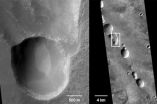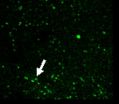(Press-News.org) This news release is available in Spanish.
There is an optimum size for electrical networks if what is being considered is the risk of a blackout. This is the conclusion reached by a scientific study done by researchers at Universidad Carlos III in Madrid; the study analyzes the dynamics of these complex infrastructures.
In 1928, the British biologist and geneticist John Haldane wrote the essay "On being the right size" in which he stated that "For every type of animal there is a most convenient size, and a large change in size inevitably carries with it a change of form". The application of Haldane's Principle spread to fields like physiology and paleontology, and there was speculation that it could be used with institutions and social organizations, as well. And that is precisely what these researchers have done with social infrastructures as complex as electrical networks. In light of Haldane's comments, the scientists wondered if the expansion of these networks should continue or if, on the contrary, there is an optimum adequate size for their correct functioning. The answer is yes, according to the results of the power network model that these UC3M scientists, in collaboration with researchers at the University of Alaska Fairbanks and Iowa State University (both in the USA), used in the study, which was recently published in the journal Chaos.
To sum up: size matters if the risk of a blackout is being taken into account. "Risk is defined as the product of the probability of failure multiplied by the cost it generates," explains researcher Benjamín Carreras, the 2014 Chair of Excellence in UC3M's Physics Department. "When small networks join together, a lot of local black-outs are avoided, generally reducing costs; in contrast, huge black-outs occur in the large networks and, although they are very infrequent, they have an enormous cost, which limits the acceptable size for networks of this kind," states Carreras, who makes this important point regarding the cost-benefit ratio, "The short-term benefits are mainly for the electrical companies, but it is not very clear who pays for the large black-outs, so there may not be a lot of interest in changing things."
To reach these conclusions the researchers simulated the operation of an electrical network and statistically measured the risk of failures in the energy supply in function of the size of the infrastructures. To do this, they maintained a set of fixed conditions, such as reliability (the probability of the failure of a component), the network's administration (how an increase in electrical demand is managed) and the environmental conditions (the influence of earthquakes, storms, etc.).
Reliability, operations and environment
The two first factors are the most important, according to the researchers, although the third is steadily growing in importance. "In a recent study it was shown that, in recent decades, there has been a systematic increase in failures in the grid due to weather conditions, probably because of climate change. We are talking about an 80% increase since 2003," points out Carreras. Nevertheless, everything depends on one's point of view; really, localized blackouts caused by storms are not necessarily bad, according to the researcher, because when they are repaired it is possible to make the systems more resistant to general blackouts.
During this study, the researchers took parameters from the electrical grid in the United States, but their models and results can be extrapolated to any type of electrical network. In fact, there are important parallelisms with other types of infrastructures, and even with economic systems: "In these systems, "blackouts" are known as "crises" and their size has increased with globalization, so it would be very interesting to apply these ideas to economic models," they note. Their conclusions lead to questioning the idea of "the bigger, the better". At least when it comes to electrical grids.
INFORMATION:
Further information:
Does size matter? B. A. Carreras. D. E. Newman. Ian Dobson. Chaos: An Interdisciplinary Journal of Nonlinear Science 24, 023104. Published online on April 8, 2014. doi: 10.1063/1.4868393 http://dx.doi.org/10.1063/1.4868393
The largest electrical networks are not the best
2014-05-12
ELSE PRESS RELEASES FROM THIS DATE:
Entering adulthood in a recession linked to lower narcissism later in life
2014-05-12
We often attribute the narcissistic tendencies of others to parenting practices or early social experiences. But new research reveals that economic conditions in the formative years of early adulthood may also play a role.
The research shows that people who entered their adulthood during hard economic times are less narcissistic later in life than those who came of age during more prosperous times.
"These findings suggest that economic conditions during this formative period of life not only affect how people think about finances and politics, but also how they think ...
Round 2: Reactions serves up a second helping of chemistry life hacks (video)
2014-05-12
WASHINGTON, May 12, 2014 — It was the video that started it all, and now the latest installment of the segment that is one-part Mendeleev, one-part MacGyver is here. The American Chemical Society's (ACS') Reactions video team is proud to debut round two of chemistry life hacks. This volume is packed full of new chemistry-fueled solutions for everyday problems, like spotting rotten eggs, reviving soggy green vegetables and fixing busted buttons. The video is available at http://youtu.be/ReGfd_s9gXA
INFORMATION:
Subscribe to the series at Reactions YouTube, and follow ...
Triple negative breast cancer, ethnicity, and socioeconomic status
2014-05-12
ATLANTA – May 12, 2014—An analysis of a large nationwide dataset finds that regardless of their socioeconomic status, black women were nearly twice as likely as white women to be diagnosed with triple-negative (TN) breast cancer, a subtype that has a poorer prognosis. The analysis also found that Asian/Pacific Islander women were more likely to be diagnosed with another subtype of breast cancer: so-called human epidermal growth factor receptor 2 (HER2)–overexpressing breast cancer. The study appears early online in Breast Cancer Research and Treatment.
Triple-negative ...
Hospitals recover from recession, some financial issues remain
2014-05-12
The recent economic recession affected hospitals across the nation, regardless of financial status, but following the rebound, financially weak and safety-net hospitals continue to struggle, according to health researchers.
"Poor financial outcomes [for hospitals] could lead to poor care," said Naleef Fareed, assistant professor of health policy and administration, Penn State. "This is an issue that needs attention as health care reform moves forward."
Fareed and colleagues used data from both the American Hospital Association Annual Survey and the Centers for Medicare ...
Man's best friend shares similar 'albino' gene
2014-05-12
Michigan State University researchers have identified a genetic mutation in Doberman pinschers that causes albinism in the breed, a discovery that has eluded veterinarians and breeders worldwide up until now.
Paige Winkler, a doctoral student in the College of Veterinary Medicine, co-led the study with Joshua Bartoe, an assistant professor in the Department of Small Animal Clinical Sciences, and discovered a mutated gene that is associated with a form of albinism in humans.
"What we found was a gene mutation that results in a missing protein necessary for cells to ...
Against the current with lava flows
2014-05-12
This news release is available in German.
An Italian astronomer in the 19th century first described them as 'canali' – on Mars' equatorial region, a conspicuous net-like system of deep gorges known as the Noctis Labyrinthus is clearly visible. The gorge system, in turn, leads into another massive canyon, the Valles Marineris, which is 4,000 km long, 200 km wide and 7 km deep. Both of these together would span the US completely from east to west.
As these gorges, when observed from orbit, resemble terrestrial canyons formed by water, most researchers assumed that ...
Drug therapy for allergy moves forward
2014-05-12
Researchers have identified several target molecules which are suitable for the development of new allergy drugs. The Journal of Allergy and Clinical Immunology, the most prestigious journal in the field of allergology, has recently published an extensive review article on the prospects of drug therapy for allergy. Completed in a large-scale EU project, the lead author of the review article is Professor Ilkka Harvima of the University of Eastern Finland and Kuopio University Hospital.
Immediate allergic reactions and allergic diseases such as allergic rhinitis, asthma ...
Role of pro-urokinase in neuronal apoptosis and revascularization after ACI
2014-05-12
Among the drugs used for acute ischemic stroke, recombinant tissue plasminogen activator is widely accepted internationally. In China, urokinase has been widely used for thrombolysis after acute ischemic stroke. Pro-urokinase is the precursor of urokinase. Compared with urokinase, pro-urokinase has greater ability to dissolve thrombus and is safer to use. However, most countries do not recognize urokinase for thrombolytic treatment after acute ischemic stroke, which has not been approved for clinical use. Dr. Wenli Hu and team from Beijing Chao-Yang Hospital, Capital Medical ...
Unusual neural connection between injured cingulum and brainstem in a SAH patients
2014-05-12
The cingulum is an important pathway for cholinergic innervation for the cerebral cortex. Many studies have reported connections between the cholinergic nuclei, especially between the cholinergic nuclei in the basal forebrain and those in the brainstem via the fornix and thalamus. However, little is known about the connection between cholinergic nuclei in the basal forebrain and cholinergic nuclei in the brainstem via the cingulum. Even no study on this phenomenon after cerebral hemorrhage has been reported. Dr. Sung Ho Jang and team from College of Medicine, Yeungnam University ...
Molecular regulation of hypoxic-ischemic brain damage
2014-05-12
Oligodendrocyte lineage gene 1 (Olig1) plays a key role in hypoxic-ischemic brain damage and myelin repair. miRNA-9 is involved in the occurrence of many related neurological disorders. Bioinformatics analysis demonstrated that miRNA-9 complementarily, but incompletely, bound oligodendrocyte lineage gene 1, but whether miRNA-9 regulates oligodendrocyte lineage gene 1 remains poorly understood. Dr. Lijun Yang and co-workers from Beijing Friendship Hospital, Capital Medical University in China prepared whole brain slices from a rat model of oxygen-glucose deprivation and ...





